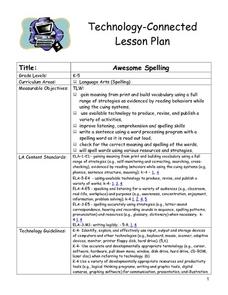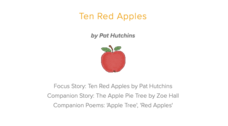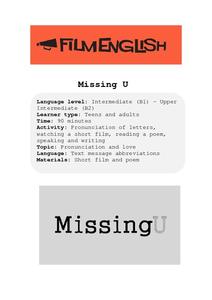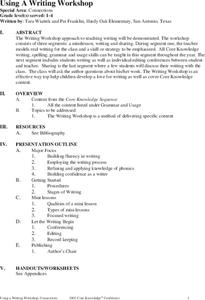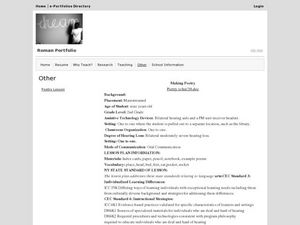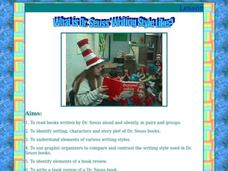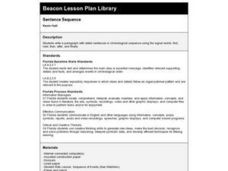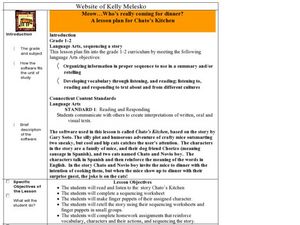Willow Tree
Linear Relationships
There's just something special about lines in algebra. Introduce your classes to linear equations by analyzing the linear relationship. Young mathematicians use input/output pairs to determine the slope and the slope-intercept formula to...
EngageNY
Creating Division Stories
Create your own adventure story ... well, not really. The fifth lesson in a 21-part series has pairs create story contexts for division problems. The lesson presents a step-by-step process for pupils to follow in writing such stories.
Curated OER
Following a Recipe
Students create a cookbook. In this recipe and writing lesson, students brainstorm the skills necessary to follow a recipe, watch a cooking show and write down a recipe used. Students use a word processing program to write a...
Curated OER
Awesome Spelling
Students are introduced to spelling words as a whole class by viewing a PowerPoint. They spell the word, repeat and spell the word again as a whole class. Pupils create a sentence orally using the list of words. Students work in small...
Virginia Department of Education
Media Literacy and Persuasive Writing
Investigate ways to persuade by introducing learners to the three rhetorical appeals (Pathos, Logos, Ethos). Pupils receive a worksheet for their definition development of the terms and coinciding vocabulary words. The activity continues...
Curated OER
Reading Meet Writing
Thinking about introducing your middle schoolers to reading log journals? Try the approach suggested by this resource. After reading to the class an article or portion of a novel, demonstrate a Think Aloud and then model how to transform...
Pearson
Rumpelstiltskin
Classic fairy tales are great! They have memorable characters, present interesting story lines, and lend themselves to art projects. Grab a copy of "Rumpelstiltskin" and get ready to participate in several early literacy activities. The...
Curated OER
Ten Red Apples; The Five Senses
A clever instructional activity designed around an apple awaits your learners. Descriptive words are used to explain what they believe is inside a bag while using their five senses. Students read the story The Apple Pie Tree and are...
Curated OER
The Personal Narrative - Part One
Read to write! The class lists sensory details based on the plot of a story they have recently read. They create a drawing of a bracelet and use the bracelet's jewels or charms to list sensory details included in the story. They then use...
EngageNY
Inferring About Characters Based on How They Respond to Challenges (Chapter 4: "Los Higos/Figs")
How do you know what a character's personality is like if an author doesn't tell you? With a focus on character development in Esperanza Rising, pupils complete a jigsaw activity to analyze the actions of Mama, Abuelita, and Miguel. Once...
Scholastic
Story Board
Invite your pupils to tell and show what happened in a story that they read by filling out this organizer. Using images and words, kids can fill out the six panels provided here to demonstrate understanding of the sequence of events and...
Scholastic
A Tale to Tell!
A creative spin occurs when one pupil acts as author Ann M. Martin. Using a Q & A at the back of her book A Dog's Life, other classmates ask the "author" questions. They discuss the reasons why they know the book is from a...
Film English
Missing U
Explore the relationship between U and I with a video and related activities. First, pupils have some fun with the alphabet and discuss text message language. Next they practice coming up with words that have the same sound a I and...
Curated OER
Using a Computer to Write a Letter – Verbs (Sequencing)
In this sequencing learning exercise, students will cut out sentences about how to write a letter using a computer. Then students will rearrange the sentence strips in chronological order.
Curated OER
Picture This!
First graders watch the teacher model how to draw pictures and write words in a First, Next, Then, Last - 4 block graphic organizer. They write and draw in their own 4 block papers.
Curated OER
Using a Writing Workshop
Students observe modeling of the writing workshop. In this writing workshop lesson, students understand that the writing workshop will be taught throughout the year and each lesson will be a segment which will be discussed.
Curated OER
Making Poetry
A hearing impaired student identifies rhyming words. In this rhyming word lesson plan for the hearing impaired, 2nd graders read and write poetry correctly using rhyming words.
Curated OER
Dr. Seuss
Students read books by the same author and compare what they find. In this Dr. Seuss lesson, students learn about Dr. Seuss' writing style, listen for the rhyme scheme in his stories, and create a KWL chart on Dr. Seuss. ...
Curated OER
Literary Lingo
Students make connections between reading and writing. In this language arts lesson, students explore literary elements as they examine a number of texts and practice implementing figurative language into their writing.
Curated OER
Sentence Sequence
Second graders write a paragraph with detail sentences in chronological sequence.
Curated OER
Peter and the Wolf - Sequencing
Students listen to the story of Peter and the Wolf and answer comprehension questions. They then will name the beginning, middle, and end of the story using a graphic organizer. Students then individually illustrate each part of the...
Curated OER
Creative Writing Lesson Plan
Students practice recognizing the elements needed to produce a piece of creative writing and become aware of those elements in their own original pieces of writings. In groups, they creatively write a new story utilizing all the major...
Curated OER
Lesson Plan for Chato's Kitchen
Through an exploration of Chato's Kitchen by Gary Soto, learners practice sequencing skills, retelling a story, and Spanish vocabulary words. All of the necessary resources, worksheets, and other materials are provided in order to give...
CC Homestead
Summarize
Designed for third graders but appropriate for older learners as well, this packet of materials underscores the necessity of teaching kids how to summarize, how to identify main ideas and supporting details, and how to ask questions...



